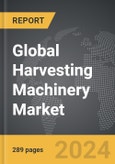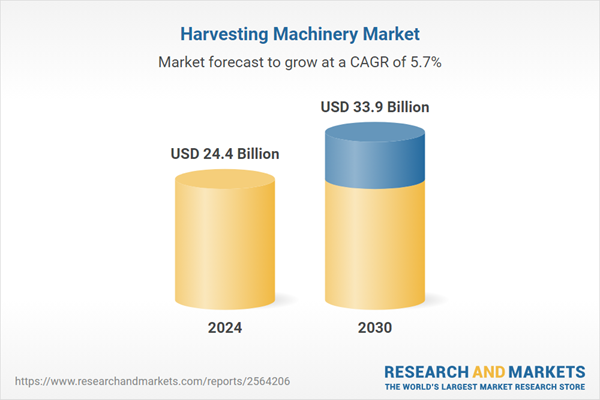The global market for Harvesting Machinery was valued at US$24.4 Billion in 2024 and is projected to reach US$33.9 Billion by 2030, growing at a CAGR of 5.7% from 2024 to 2030. This comprehensive report provides an in-depth analysis of market trends, drivers, and forecasts, helping you make informed business decisions. The report includes the most recent global tariff developments and how they impact the Harvesting Machinery market.
The global market for harvesting machinery is driven by several growth factors, chief among them being the escalating demand for agricultural products and the widespread adoption of advanced farming technologies. Technological enhancements in harvesting machinery, such as improved sensors and automated systems, have made these machines more efficient and appealing to the farming community. Moreover, government initiatives, especially in developing countries like India, provide substantial support through subsidies and favorable policies, encouraging farmers to invest in modern equipment. These initiatives, coupled with the need to boost productivity to meet growing food demands, are propelling the market for agricultural harvesting machinery forward. Programs like Rashtriya Krishi Vikas Yojna (RKVY) and the National Food Security Mission (NFSM) are instrumental in promoting the use of efficient machinery through financial aids such as subsidies, making it more feasible for farmers to upgrade their equipment.
Emerging trends such as Precision Farming are further shaping the harvesting machinery market by utilizing electronic sensors and cloud-based technologies to optimize yields and improve crop quality. This approach supports the precision farming technique, enhancing the efficiency of operations and the quality of harvests. The adoption of these advanced machines is especially pronounced in regions like Europe and Asia-Pacific, where there is a critical combination of labor shortages and a pressing need for increased agricultural productivity. The government's role in facilitating access to high-end machinery through subsidies is a significant growth driver in these regions, making sophisticated technology accessible and affordable for local farmers. As the harvesting machinery market continues to grow, driven by technological advancements, government incentives, and an increasing need for efficiency and quality in agricultural outputs, the future of farming looks geared towards even greater mechanization and productivity, ensuring the industry can meet the escalating global food demands effectively.
Segments: Machinery Type (Combine Harvester, Forage Harvester, Sugarcane Harvester, Other Machinery Types).
Geographic Regions/Countries: World; United States; Canada; Japan; China; Europe (France; Germany; Italy; United Kingdom; Spain; Russia; and Rest of Europe); Asia-Pacific (Australia; India; South Korea; and Rest of Asia-Pacific); Latin America (Argentina; Brazil; Mexico; and Rest of Latin America); Middle East (Iran; Israel; Saudi Arabia; United Arab Emirates; and Rest of Middle East); and Africa.
The analysts continuously track trade developments worldwide, drawing insights from leading global economists and over 200 industry and policy institutions, including think tanks, trade organizations, and national economic advisory bodies. This intelligence is integrated into forecasting models to provide timely, data-driven analysis of emerging risks and opportunities.
Global Harvesting Machinery Market - Key Trends and Drivers Summarized
Harvesting machinery, an essential component of modern agriculture, has evolved significantly with technological advancements, significantly impacting farming efficiency and productivity. This evolution began with the Industrial Revolution and has continued to grow, incorporating complex technologies such as GPS and automation into farming equipment. These innovations have transformed traditional farming practices, enabling farmers to manage larger plots more effectively, thereby increasing crop yields and reducing labor costs. The integration of sophisticated machinery in the agricultural sector allows for faster completion of farming tasks, minimizing crops' exposure to environmental risks, and enhancing yield quality. Additionally, mechanization addresses the labor shortages often experienced in rural areas, a consequence of urban migration, by reducing the dependency on manual labor which is increasingly scarce and expensive.The global market for harvesting machinery is driven by several growth factors, chief among them being the escalating demand for agricultural products and the widespread adoption of advanced farming technologies. Technological enhancements in harvesting machinery, such as improved sensors and automated systems, have made these machines more efficient and appealing to the farming community. Moreover, government initiatives, especially in developing countries like India, provide substantial support through subsidies and favorable policies, encouraging farmers to invest in modern equipment. These initiatives, coupled with the need to boost productivity to meet growing food demands, are propelling the market for agricultural harvesting machinery forward. Programs like Rashtriya Krishi Vikas Yojna (RKVY) and the National Food Security Mission (NFSM) are instrumental in promoting the use of efficient machinery through financial aids such as subsidies, making it more feasible for farmers to upgrade their equipment.
Emerging trends such as Precision Farming are further shaping the harvesting machinery market by utilizing electronic sensors and cloud-based technologies to optimize yields and improve crop quality. This approach supports the precision farming technique, enhancing the efficiency of operations and the quality of harvests. The adoption of these advanced machines is especially pronounced in regions like Europe and Asia-Pacific, where there is a critical combination of labor shortages and a pressing need for increased agricultural productivity. The government's role in facilitating access to high-end machinery through subsidies is a significant growth driver in these regions, making sophisticated technology accessible and affordable for local farmers. As the harvesting machinery market continues to grow, driven by technological advancements, government incentives, and an increasing need for efficiency and quality in agricultural outputs, the future of farming looks geared towards even greater mechanization and productivity, ensuring the industry can meet the escalating global food demands effectively.
Report Scope
The report analyzes the Harvesting Machinery market, presented in terms of units. The analysis covers the key segments and geographic regions outlined below.Segments: Machinery Type (Combine Harvester, Forage Harvester, Sugarcane Harvester, Other Machinery Types).
Geographic Regions/Countries: World; United States; Canada; Japan; China; Europe (France; Germany; Italy; United Kingdom; Spain; Russia; and Rest of Europe); Asia-Pacific (Australia; India; South Korea; and Rest of Asia-Pacific); Latin America (Argentina; Brazil; Mexico; and Rest of Latin America); Middle East (Iran; Israel; Saudi Arabia; United Arab Emirates; and Rest of Middle East); and Africa.
Key Insights:
- Market Growth: Understand the significant growth trajectory of the Combine Harvester segment, which is expected to reach US$13.9 Billion by 2030 with a CAGR of a 6.6%. The Forage Harvester segment is also set to grow at 5.6% CAGR over the analysis period.
- Regional Analysis: Gain insights into the U.S. market, valued at $6.6 Billion in 2024, and China, forecasted to grow at an impressive 9.3% CAGR to reach $7.3 Billion by 2030. Discover growth trends in other key regions, including Japan, Canada, Germany, and the Asia-Pacific.
Why You Should Buy This Report:
- Detailed Market Analysis: Access a thorough analysis of the Global Harvesting Machinery Market, covering all major geographic regions and market segments.
- Competitive Insights: Get an overview of the competitive landscape, including the market presence of major players across different geographies.
- Future Trends and Drivers: Understand the key trends and drivers shaping the future of the Global Harvesting Machinery Market.
- Actionable Insights: Benefit from actionable insights that can help you identify new revenue opportunities and make strategic business decisions.
Key Questions Answered:
- How is the Global Harvesting Machinery Market expected to evolve by 2030?
- What are the main drivers and restraints affecting the market?
- Which market segments will grow the most over the forecast period?
- How will market shares for different regions and segments change by 2030?
- Who are the leading players in the market, and what are their prospects?
Report Features:
- Comprehensive Market Data: Independent analysis of annual sales and market forecasts in US$ Million from 2024 to 2030.
- In-Depth Regional Analysis: Detailed insights into key markets, including the U.S., China, Japan, Canada, Europe, Asia-Pacific, Latin America, Middle East, and Africa.
- Company Profiles: Coverage of players such as AGCO Corporation, CLAAS KGaA mbH, CNH Industrial N.V., Deere & Company (John Deere), Dewulf NV and more.
- Complimentary Updates: Receive free report updates for one year to keep you informed of the latest market developments.
Some of the 73 companies featured in this Harvesting Machinery market report include:
- AGCO Corporation
- CLAAS KGaA mbH
- CNH Industrial N.V.
- Deere & Company (John Deere)
- Dewulf NV
- Kubota Corp.
- Lovol Heavy Industry Co.Ltd.
- Preet Agro Industries Pvt. Ltd.
- Rostselmash
- SAME Deutz Fahr
- Sampo Rosenlew Ltd.
Tariff Impact Analysis: Key Insights for 2025
Global tariff negotiations across 180+ countries are reshaping supply chains, costs, and competitiveness. This report reflects the latest developments as of April 2025 and incorporates forward-looking insights into the market outlook.The analysts continuously track trade developments worldwide, drawing insights from leading global economists and over 200 industry and policy institutions, including think tanks, trade organizations, and national economic advisory bodies. This intelligence is integrated into forecasting models to provide timely, data-driven analysis of emerging risks and opportunities.
What’s Included in This Edition:
- Tariff-adjusted market forecasts by region and segment
- Analysis of cost and supply chain implications by sourcing and trade exposure
- Strategic insights into geographic shifts
Buyers receive a free July 2025 update with:
- Finalized tariff impacts and new trade agreement effects
- Updated projections reflecting global sourcing and cost shifts
- Expanded country-specific coverage across the industry
Table of Contents
I. METHODOLOGYII. EXECUTIVE SUMMARYIII. MARKET ANALYSISSOUTH KOREAREST OF ASIA-PACIFICARGENTINABRAZILMEXICOREST OF LATIN AMERICAIRANISRAELSAUDI ARABIAUNITED ARAB EMIRATESREST OF MIDDLE EASTIV. COMPETITION
1. MARKET OVERVIEW
2. FOCUS ON SELECT PLAYERS
3. MARKET TRENDS & DRIVERS
4. GLOBAL MARKET PERSPECTIVE
UNITED STATES
CANADA
JAPAN
CHINA
EUROPE
FRANCE
GERMANY
ITALY
UNITED KINGDOM
SPAIN
RUSSIA
REST OF EUROPE
ASIA-PACIFIC
AUSTRALIA
INDIA
LATIN AMERICA
MIDDLE EAST
AFRICA
Companies Mentioned (Partial List)
A selection of companies mentioned in this report includes, but is not limited to:
- AGCO Corporation
- CLAAS KGaA mbH
- CNH Industrial N.V.
- Deere & Company (John Deere)
- Dewulf NV
- Kubota Corp.
- Lovol Heavy Industry Co.Ltd.
- Preet Agro Industries Pvt. Ltd.
- Rostselmash
- SAME Deutz Fahr
- Sampo Rosenlew Ltd.
Table Information
| Report Attribute | Details |
|---|---|
| No. of Pages | 289 |
| Published | April 2025 |
| Forecast Period | 2024 - 2030 |
| Estimated Market Value ( USD | $ 24.4 Billion |
| Forecasted Market Value ( USD | $ 33.9 Billion |
| Compound Annual Growth Rate | 5.7% |
| Regions Covered | Global |









